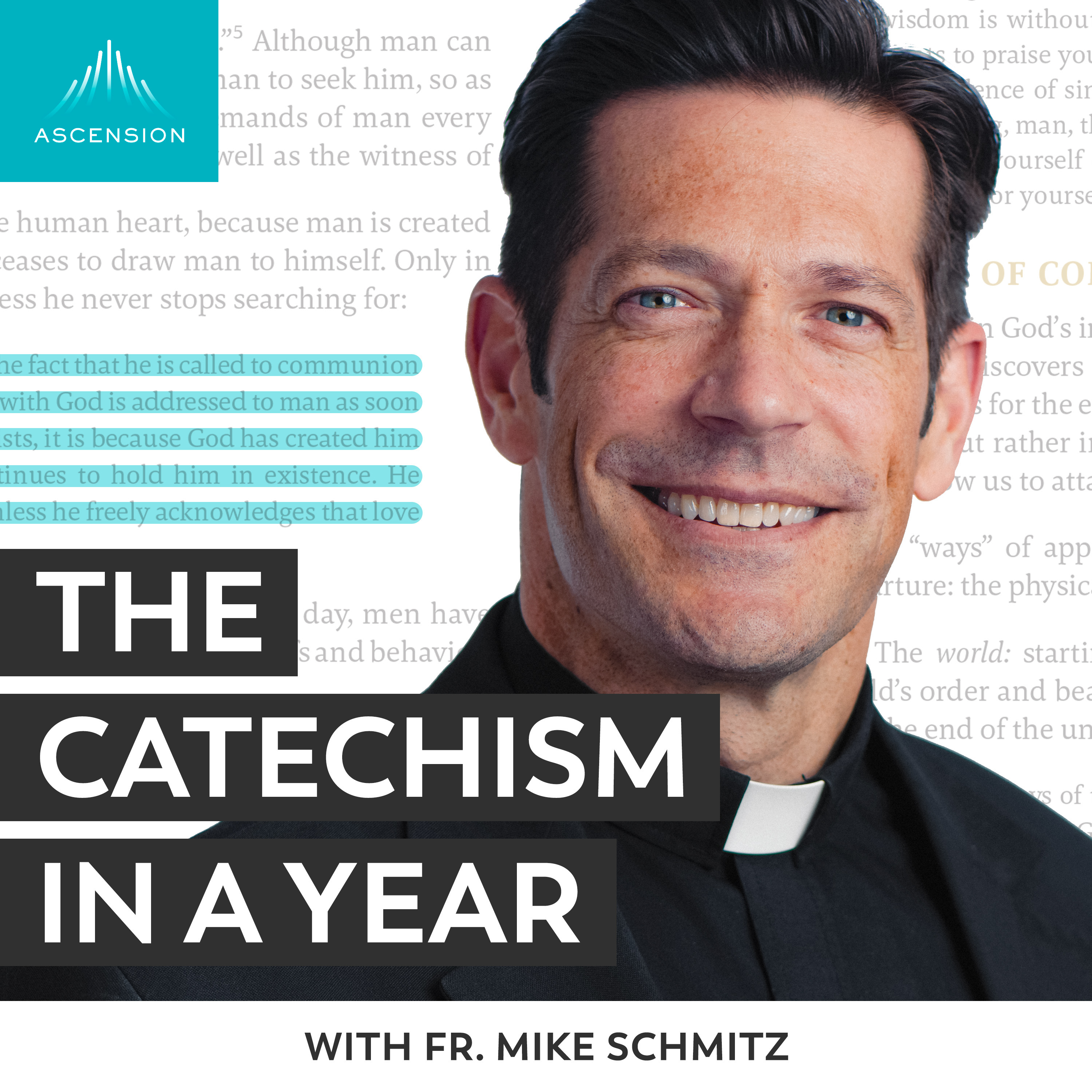
Catholicism 101: Forever Learning and Living the Faith
Learning the Catholic Faith is a lifelong process. For many of us, it may have had a rocky start from a lack-luster classroom experience, being a disinterested student, or a lack of exposure to the teachings of the Faith. Catholicism 101 is here to fill in the gaps from your Religious Education experience as well as serve as an aid in your lifelong learning of the Faith. Not only will we talk about WHAT the Church teaches, but WHY she teaches it. Hopefully along the way we will find ourselves falling deeper into the heart of Christ as we learn more about His heart for us.
"Always be ready to give an explanation to anyone who asks you for a reason for your hope." 1 Peter 3:15
Have a question about the Faith you’d like to have answered on the Podcast? Submit it here: https://forms.gle/zorQwuUGtSdukzjc6
Emily Gipson | Director of Catechetical Formation - St. Mary of the Woods Catholic Church | Whitesville, KY
Catholicism 101: Forever Learning and Living the Faith
E20: Unity of Posture as the Body of Christ
What is the difference between the practices of our personal prayer and those of community worship? Why does maintaining unity of posture during Mass matter?
Join us for this month’s episode of Catholicism 101 as we dig into why our Bishops call for outward unity in liturgical celebrations and what issues are actually caused by disregarding their guidelines for public worship.
Resources:
- Cardinal Cupich’s statement in Chicago Archdiocese Newspaper (Chicago Catholic) 12/11/2024
- Deacon Ken Bennett – WKC Article: “Sacrament of Unity: How to properly receive Holy Communion”
- Instruction on the Ecclesial Vocation of the Theologian | CDF
- General Instruction of the Roman Missal
- Congregation for Divine Worship and the Discipline of the Sacraments, Redemptionis Sacramentum
Have a question about the Faith you’d like to have answered on the Podcast? Submit it here: https://forms.gle/zorQwuUGtSdukzjc6
Episode 20 – Unity of Posture as the Body of Christ
· The Mass is a Sacrament – the Eucharist; Sacraments are efficacious, meaning what they symbolize is actually happening on a much more real level
o Eucharist is also called Communion (common union à unity/oneness) Receiving the Eucharist is not a private action but rather a communal one, as the very word ‘communion’ implies
o In order to maintain the symbolism of our common union as the body of Christ, the Bishops ask us to maintain unity of posture in our reception of Holy Communion
§ Though it may seem like splitting hairs or minute, drawing attention to oneself (even though this is more than likely not the person’s intention) by receiving communion differently than the rest of the community symbolizes division and therefore plants a seed for disunity and scandal.
§ “Disrupting this moment only diminishes this powerful symbolic expression, by which the faithful in processing together express their faith that they are called to become the very Body of Christ they receive.” – Cardinal Cupich in his letter “As we Pray..” in the December 2024 edition of the Archdiocese’s newspaper, ChicagoCatholic
o Appropriate Posture, Gesture, & Dialogue as established by The General Instruction of the Roman Missal (GIRM) paragraphs 86, 160-164 (citing Redemptionis Sacramentum, 91)
§ Posture: The norm established for Dioceses in the United States is that Holy Communion is to be received standing. Those who choose to kneel will not be denied communion.
§ Gesture: When receiving Holy Communion, the communicant bows his or her head before the sacrament as a gesture of reverence and receives the Body of the Lord from the minister. The gesture is repeated before receiving the Precious Blood.
§ Dialogue: The minster says “The Body of Christ” or “The Blood of Christ. To each, the communicant responds, “Amen.”
· There are certain things that are not good to do no matter what your intention is or the circumstances are. Though your circumstances might lessen the degree to which you should be held accountable, it doesn’t change the fact that these behaviors still have bad effects, regardless of your intention or knowledge about its seriousness.
o There is a goodness and a beauty in hearts that desire to show the greatest reverence to the Lord in the Most Blessed Sacrament—there is indeed a mysticism and deep love for the Lord there—but we are asked to submit to the authority of the Church & shown the hidden beauty of it by the humility of St. John—the beloved disciple.
· Mysticism submitting to the authority of the Church: Although many people read this account in John’s Gospel as him subtly bragging about beating Peter to the tomb, the story actually showcases John’s virtuous, humble obedience in a much greater way.
o (Jn 20:1-10) On the first day of the week, Mary of Magdala came to the tomb early in the morning, while it was still dark, and saw the stone removed from the tomb. So she ran and went to Simon Peter and to the other disciple whom Jesus loved, and told them, “They have taken the Lord from the tomb, and we don’t know where they put him.” So Peter and the other disciple went out and came to the tomb. They both ran, but the other disciple ran faster than Peter and arrived at the tomb first; he bent down and saw the burial cloths there, but did not go in. When Simon Peter arrived after him, he went into the tomb and saw the burial cloths there, and the cloth that had covered his head, not with the burial cloths but rolled up in a separate place. Then the other disciple also went in, the one who had arrived at the tomb first, and he saw and believed. For they did not yet understand the scripture that he had to rise from the dead. Then the disciples returned home.
§ John, the beloved disciple, has been the primary apostolic representation of the contemplative, mystical life throughout the history and tradition of the Church. He teaches us the beauty and goodness of the spiritual life as an intimate relationship with the Lord. This intimate relationship with Christ then draws us into the greater Body of Christ—the Church.
§ Peter, the rock on which Christ has built his Church, forever stands as the representation and embodiment of the authority of the Church—“And so I say to you, you are Peter, and upon this rock I will build my church, and the gates of the netherworld shall not prevail against it. I will give you the keys to the kingdom of heaven. Whatever you bind on earth shall be bound in heaven; and whatever you loose on earth shall be loosed in heaven.” (Mt 16:18-19)
· The Congregation for the Doctrine of the Faith released a document in 1990 entitled, “Donum Veritatis: On the Ecclesial Vocation of the Theologian,” written by Cardinal Joseph Ratzinger who served as the prefect for the CDF prior to his election as Pope Benedict XVI
o The Church, which has her origin in the unity of the Father, Son, and Holy Spirit, is a mystery of communion. In accordance with the will of her founder, she is organized around a hierarchy established for the service of the Gospel and the People of God who live by it. After the pattern of the members of the first community, all the baptized with their own proper charisms are to strive with sincere hearts for a harmonious unity in doctrine, life, and worship (cf. Acts 2:42). This is a rule which flows from the very being of the Church. For this reason, standards of conduct, appropriate to civil society or the workings of a democracy, cannot be purely and simply applied to the Church. Even less can relationships within the Church be inspired by the mentality of the world around it (ct. Rom 12:2). Polling public opinion to determine the proper thing to think or do, opposing the Magisterium by exerting the pressure of public opinion, making the excuse of a "consensus" among theologians, maintaining that the theologian is the prophetical spokesman of a "base" or autonomous community which would be the source of all truth, all this indicates a grave loss of the sense of truth and of the sense of the Church. The Church "is like a sacrament, a sign and instrument, that is, of communion with God and of unity among all men.” Consequently, to pursue concord and communion is to enhance the force of her witness and credibility. To succumb to the temptation of dissent, on the other hand, is to allow the "leaven of infidelity to the Holy Spirit" to start to work. (Donum Veritatis, 39-40)
§ Though there’s a difference between a formally, academically-trained theologian and one who studies theology informally, all who do theology are bound to submission of the Church
· As we grow closer to the Lord in an intimate relationship with him (like John) we are also growing closer to one another in the larger Body of Christ. If we find that there is dissension and conflict between our personal relationship with the Lord and what the Magisterium of the Church has put forth for the benefit of the faithful, we are called to (1) an honest examination of our part in the disruption of unity, (2) seeking deeper understanding of why the Church takes this particular stance—aka an informal study of theology as ‘faith seeking understanding,’ and (3) exercising humble obedience with charity so as to not cause further division among the faithful—‘willing the good for the sake of the other’ especially in the midst of potential pride.
· Good desire for renewal of the Liturgy—called for by Vatican II & affirmed by Cupich’s statement:
o “By recognizing this relationship between how we worship and what we believe, the bishops at the council made clear that the renewal of the liturgy in the life of the church is central to the mission of proclaiming the Gospel. It would be a mistake to reduce the renewal to a mere updating of our liturgy to fit the times we live in, as if it were a kind of liturgical facelift. We need the restoration of the liturgy because it gives us the capacity to proclaim Christ to the world.” – Cardinal Cupich in his letter “As we Pray..” in the December 2024 edition of the Archdiocese’s newspaper, ChicagoCatholic
§ We must keep in mind that we, as the lay faithful, do not carry the authority given by the Holy Spirit to the Magisterium. Our practices of personal piety have a time and a place, and the Lord sees our hearts and desire to love him as best we know how. As beautiful and good as our mysticism or personal relationship with the Lord is, he still asks us to submit to the authority of the shepherds entrusted with our care.
o In addition, it historically takes around 100 years or so following the conclusion of an ecumenical council to fully sort through any chaos/misinterpretation/misunderstanding of the specific changes put forth by the council fathers. Being that it is 2025 and Vatican II concluded in 1965, we’re only 60 years into the post-conciliar period of fine-tuning. So simmer down now—we’ve still got roughly 40 more years of being led by the Spirit to a more fully-developed understanding of the council. Even if you get to the tomb first, we are called to submit to the authority of the Church & recognize that until there is a Petrine seal of approval, we are subject to error.
Podcasts we love
Check out these other fine podcasts recommended by us, not an algorithm.

Ask Christopher West
Theology of the Body Institute
Chris Stefanick Catholic Show
Chris Stefanick | Real Life Catholic

